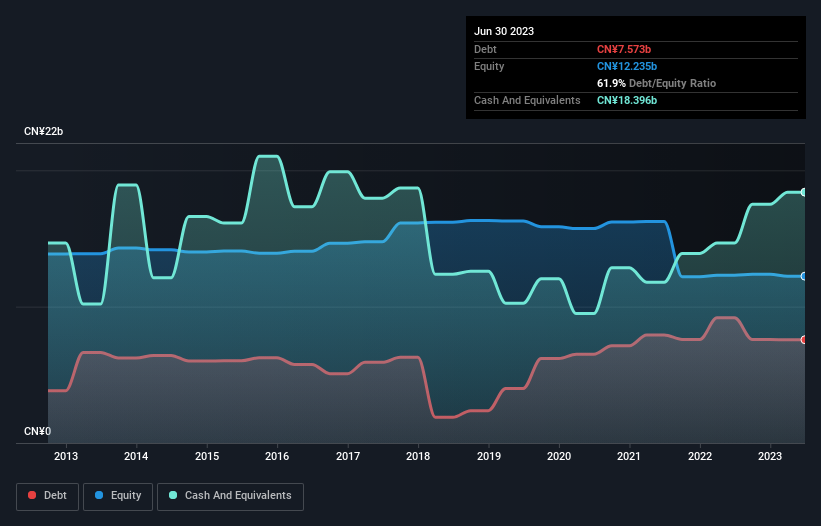- Hong Kong
- /
- Electrical
- /
- SEHK:1133
Harbin Electric (HKG:1133) Has Debt But No Earnings; Should You Worry?

The external fund manager backed by Berkshire Hathaway's Charlie Munger, Li Lu, makes no bones about it when he says 'The biggest investment risk is not the volatility of prices, but whether you will suffer a permanent loss of capital.' So it might be obvious that you need to consider debt, when you think about how risky any given stock is, because too much debt can sink a company. We can see that Harbin Electric Company Limited (HKG:1133) does use debt in its business. But should shareholders be worried about its use of debt?
When Is Debt Dangerous?
Debt assists a business until the business has trouble paying it off, either with new capital or with free cash flow. In the worst case scenario, a company can go bankrupt if it cannot pay its creditors. However, a more common (but still painful) scenario is that it has to raise new equity capital at a low price, thus permanently diluting shareholders. Of course, debt can be an important tool in businesses, particularly capital heavy businesses. The first step when considering a company's debt levels is to consider its cash and debt together.
Check out our latest analysis for Harbin Electric
How Much Debt Does Harbin Electric Carry?
The image below, which you can click on for greater detail, shows that Harbin Electric had debt of CN¥7.57b at the end of June 2023, a reduction from CN¥9.18b over a year. But on the other hand it also has CN¥18.4b in cash, leading to a CN¥10.8b net cash position.

How Healthy Is Harbin Electric's Balance Sheet?
According to the last reported balance sheet, Harbin Electric had liabilities of CN¥52.9b due within 12 months, and liabilities of CN¥4.16b due beyond 12 months. On the other hand, it had cash of CN¥18.4b and CN¥20.4b worth of receivables due within a year. So its liabilities outweigh the sum of its cash and (near-term) receivables by CN¥18.3b.
This deficit casts a shadow over the CN¥4.18b company, like a colossus towering over mere mortals. So we definitely think shareholders need to watch this one closely. After all, Harbin Electric would likely require a major re-capitalisation if it had to pay its creditors today. Harbin Electric boasts net cash, so it's fair to say it does not have a heavy debt load, even if it does have very significant liabilities, in total. When analysing debt levels, the balance sheet is the obvious place to start. But ultimately the future profitability of the business will decide if Harbin Electric can strengthen its balance sheet over time. So if you want to see what the professionals think, you might find this free report on analyst profit forecasts to be interesting.
Over 12 months, Harbin Electric reported revenue of CN¥26b, which is a gain of 25%, although it did not report any earnings before interest and tax. Shareholders probably have their fingers crossed that it can grow its way to profits.
So How Risky Is Harbin Electric?
Although Harbin Electric had an earnings before interest and tax (EBIT) loss over the last twelve months, it made a statutory profit of CN¥132m. So when you consider it has net cash, along with the statutory profit, the stock probably isn't as risky as it might seem, at least in the short term. One positive was the revenue growth of 25% over the last year. But the stock still looks risky to us. When analysing debt levels, the balance sheet is the obvious place to start. But ultimately, every company can contain risks that exist outside of the balance sheet. For instance, we've identified 1 warning sign for Harbin Electric that you should be aware of.
At the end of the day, it's often better to focus on companies that are free from net debt. You can access our special list of such companies (all with a track record of profit growth). It's free.
Valuation is complex, but we're here to simplify it.
Discover if Harbin Electric might be undervalued or overvalued with our detailed analysis, featuring fair value estimates, potential risks, dividends, insider trades, and its financial condition.
Access Free AnalysisHave feedback on this article? Concerned about the content? Get in touch with us directly. Alternatively, email editorial-team (at) simplywallst.com.
This article by Simply Wall St is general in nature. We provide commentary based on historical data and analyst forecasts only using an unbiased methodology and our articles are not intended to be financial advice. It does not constitute a recommendation to buy or sell any stock, and does not take account of your objectives, or your financial situation. We aim to bring you long-term focused analysis driven by fundamental data. Note that our analysis may not factor in the latest price-sensitive company announcements or qualitative material. Simply Wall St has no position in any stocks mentioned.
About SEHK:1133
Harbin Electric
Manufactures and sells power plant equipment in the People’s Republic of China, the rest of Asia, Africa, Europe, and the United States.
Solid track record with excellent balance sheet.
Similar Companies
Market Insights
Community Narratives



